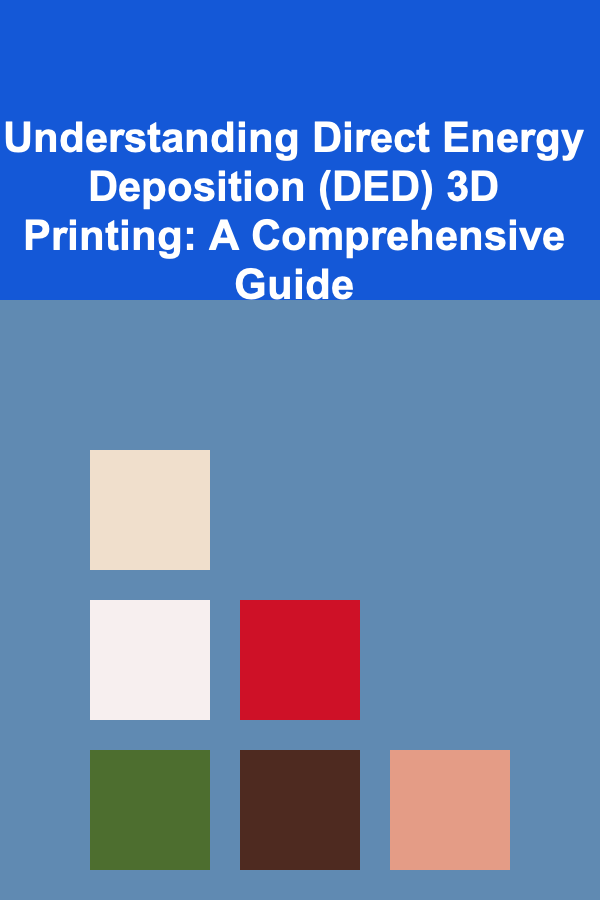
Understanding Direct Energy Deposition (DED) 3D Printing: A Comprehensive Guide
ebook include PDF & Audio bundle (Micro Guide)
$12.99$7.99
Limited Time Offer! Order within the next:

Direct Energy Deposition (DED), also known as Directed Energy Deposition, is a powerful additive manufacturing (AM) process that offers unique capabilities compared to other 3D printing technologies. It's particularly well-suited for creating large, complex metal parts, repairing existing components, and applying coatings. This comprehensive guide will delve into the intricacies of DED, exploring its working principles, advantages, disadvantages, applications, and future trends.
What is Direct Energy Deposition?
At its core, DED is an additive manufacturing process where a focused energy source, typically a laser, electron beam, or plasma arc, is used to melt material as it is being deposited. Unlike powder bed fusion (PBF) processes like Selective Laser Melting (SLM) or Electron Beam Melting (EBM) where a layer of powder is spread across a build platform, DED directly feeds material, either in powder or wire form, into the melt pool created by the energy source. The machine nozzle, which carries both the energy source and the material, moves according to a pre-defined toolpath, building up the part layer by layer.
Imagine a robotic arm holding a welding torch and simultaneously feeding metal wire into the weld pool. That's a simplified analogy for the DED process. The key difference lies in the precision control offered by DED systems, enabling the creation of intricate geometries with high material utilization.
The DED Process: A Step-by-Step Breakdown
Understanding the DED process involves breaking it down into several key steps:
- Design and Preprocessing: The process begins with a 3D CAD model of the desired part. This model is then sliced into layers, and a toolpath is generated. The toolpath dictates the movement of the DED head, including the speed, power, and material feed rate, to ensure accurate and consistent deposition. This preprocessing step is crucial for optimizing the build parameters and minimizing defects.
- Material Feeding: DED systems use either powder or wire as feedstock.
- Powder-based DED: Powder is typically fed through a nozzle using a carrier gas (e.g., argon or helium). The powder is precisely metered into the gas stream, ensuring a consistent and controlled flow into the melt pool. Multiple nozzles can be used surrounding the laser to deliver the powder.
- Wire-based DED: Wire is fed directly into the melt pool via a feeder mechanism. Wire-based systems often offer higher deposition rates compared to powder-based systems.
- Energy Source Application: The focused energy source, whether a laser, electron beam, or plasma arc, is directed onto the substrate or previously deposited layer. The energy source melts a small area, creating a molten pool.
- Material Deposition: Simultaneously with the energy source application, the feedstock material (powder or wire) is fed into the melt pool. The material melts upon contact with the molten pool and solidifies as the DED head moves along the toolpath.
- Layer-by-Layer Fabrication: The DED head continues to move according to the toolpath, depositing material and building up the part layer by layer. Each layer is fused to the previous layer, creating a solid, three-dimensional object.
- Post-Processing: Once the part is complete, it may require post-processing steps such as heat treatment, machining, or surface finishing. Heat treatment can relieve residual stresses and improve the material's mechanical properties. Machining can be used to achieve tighter tolerances or improve surface finish.
Types of DED Technologies: A Comparison
While the fundamental principle remains the same, different DED technologies utilize different energy sources and material delivery methods. The most common types include:
- Laser Engineered Net Shaping (LENS): LENS, developed by Optomec, uses a high-power laser to melt metal powder as it is blown into the melt pool. It's known for its precision and ability to create complex geometries with good material properties. LENS typically operates in a controlled atmosphere (e.g., argon) to minimize oxidation.
- Electron Beam Additive Manufacturing (EBAM): EBAM, pioneered by Sciaky, uses a high-energy electron beam to melt metal wire. EBAM operates in a vacuum environment, which further reduces oxidation and allows for the processing of reactive materials like titanium. EBAM generally has higher deposition rates than LENS, making it suitable for larger parts.
- Wire Arc Additive Manufacturing (WAAM): WAAM utilizes an electric arc as the energy source to melt metal wire. WAAM offers very high deposition rates and is particularly well-suited for creating large-scale parts. While WAAM generally has lower precision compared to LENS or EBAM, it remains a cost-effective option for many applications. It can operate in an open atmosphere or with inert gas shielding.
- Laser Cladding: Laser cladding is a specific type of DED primarily used for applying coatings or repairing surfaces. It utilizes a laser to fuse a thin layer of material onto a substrate, providing wear resistance, corrosion protection, or other desired properties.
The choice of DED technology depends on factors such as the material being used, the desired part size, the required precision, and the budget.
Materials Compatible with DED
DED's versatility extends to a wide range of materials, primarily metals, but also some ceramics and composites. Common materials include:
- Titanium Alloys: Titanium alloys are widely used in aerospace, medical, and automotive applications due to their high strength-to-weight ratio and corrosion resistance. DED allows for the creation of complex titanium components that are difficult or impossible to manufacture using traditional methods.
- Nickel-based Superalloys: Nickel-based superalloys exhibit excellent high-temperature strength and creep resistance, making them ideal for gas turbine engines and other demanding applications. DED is used to produce complex turbine blades and other hot-section components.
- Stainless Steels: Stainless steels are widely used in various industries due to their corrosion resistance and relatively low cost. DED can be used to create custom stainless steel parts for chemical processing, food processing, and other applications.
- Aluminum Alloys: Aluminum alloys offer a good combination of strength and lightweight, making them suitable for aerospace, automotive, and sporting goods applications. DED is increasingly being used to produce aluminum components, though challenges related to oxidation and thermal management need to be addressed.
- Cobalt-Chromium Alloys: Cobalt-chromium alloys are commonly used in medical implants due to their biocompatibility and wear resistance. DED enables the creation of customized implants tailored to individual patient needs.
- Tool Steels: DED can be used to produce tool steel components with complex geometries and internal cooling channels, enhancing their performance and lifespan.
- Refractory Metals: DED can also be used to process refractory metals like tungsten and molybdenum, which have extremely high melting points and are used in specialized applications such as rocket nozzles and high-temperature furnaces.
Advantages of DED 3D Printing
DED offers several compelling advantages over traditional manufacturing methods and other 3D printing technologies:
- Large Part Fabrication: DED is particularly well-suited for creating large parts, often exceeding the build volume limitations of other AM processes. The ability to deposit material directly onto existing structures allows for the fabrication of even larger components.
- Repair and Refurbishment: DED is an excellent technique for repairing damaged or worn parts. Material can be selectively deposited onto the damaged area, restoring the component to its original dimensions and functionality. This is especially valuable for high-value components in industries like aerospace and energy.
- Multi-Material Deposition: Some DED systems can deposit multiple materials simultaneously or sequentially, enabling the creation of functionally graded materials (FGMs) with varying properties throughout the part. This allows for the optimization of performance characteristics such as wear resistance, corrosion resistance, and thermal conductivity.
- High Deposition Rates: DED, particularly WAAM, offers high deposition rates compared to powder bed fusion processes, making it more efficient for manufacturing large parts. This translates to shorter lead times and lower production costs.
- Material Utilization: DED generally exhibits high material utilization, as material is only deposited where it is needed. This minimizes waste and reduces the overall cost of production.
- Freedom of Design: DED allows for the creation of complex geometries and internal features that are difficult or impossible to achieve using traditional manufacturing methods. This design freedom enables the development of innovative and optimized products.
- On-Demand Manufacturing: DED enables on-demand manufacturing, allowing for the rapid production of customized parts with minimal tooling requirements. This is particularly valuable for low-volume production and prototyping.
Disadvantages of DED 3D Printing
Despite its numerous advantages, DED also has some limitations that need to be considered:
- Lower Dimensional Accuracy and Surface Finish: DED generally produces parts with lower dimensional accuracy and rougher surface finishes compared to powder bed fusion processes. Post-processing, such as machining, is often required to achieve the desired tolerances and surface quality.
- Heat Affected Zone (HAZ): The localized heating and cooling during the DED process can create a heat-affected zone (HAZ) in the surrounding material. The HAZ can exhibit altered microstructures and mechanical properties, potentially impacting the overall performance of the part. Careful control of the process parameters is crucial to minimize the HAZ.
- Residual Stresses: The rapid heating and cooling cycles during DED can induce residual stresses in the part. These stresses can lead to distortion or cracking if not properly managed. Heat treatment is often used to relieve residual stresses.
- Equipment Cost: DED systems are generally more expensive than some other 3D printing technologies, such as fused deposition modeling (FDM). The high cost of the equipment can be a barrier to entry for some companies.
- Skill and Expertise Required: Operating and maintaining DED systems requires specialized knowledge and expertise. Skilled operators and engineers are needed to optimize process parameters, troubleshoot problems, and ensure consistent part quality.
- Limited Material Selection Compared to Traditional Manufacturing: While DED is compatible with a wide range of metals, the selection is still more limited compared to what can be achieved through traditional casting or forging processes. Developing process parameters for new materials can also be time-consuming and expensive.
- Potential for Porosity: Inadequate control of process parameters, such as power, travel speed, and material feed rate, can lead to porosity in the deposited material. Porosity can weaken the part and reduce its fatigue life.
Applications of DED 3D Printing
DED is finding increasing applications across various industries, driven by its unique capabilities and advantages:
- Aerospace: DED is widely used in the aerospace industry for manufacturing large structural components, repairing turbine blades, and applying wear-resistant coatings. Examples include:
- Repairing damaged turbine blades for jet engines.
- Creating near-net-shape preforms for forging.
- Manufacturing large titanium airframe components.
- Energy: DED is used in the energy sector for repairing and manufacturing components for power generation equipment, such as gas turbines and steam turbines. It is also used for cladding pipes to improve their corrosion resistance. Examples include:
- Repairing damaged components in nuclear reactors.
- Creating wear-resistant coatings for drill bits used in oil and gas exploration.
- Manufacturing complex components for wind turbines.
- Automotive: DED is being explored in the automotive industry for creating customized parts, repairing tooling, and applying wear-resistant coatings. Examples include:
- Manufacturing customized engine components.
- Repairing damaged molds and dies.
- Creating lightweight structural components.
- Medical: DED is used in the medical field for creating customized implants, surgical tools, and dental prosthetics. Examples include:
- Manufacturing customized hip and knee implants.
- Creating complex surgical guides.
- Fabricating dental crowns and bridges.
- Defense: DED is used in the defense industry for manufacturing spare parts, repairing damaged equipment, and creating customized weapons systems. Examples include:
- Manufacturing spare parts for military vehicles.
- Repairing damaged aircraft components.
- Creating customized weapon components.
- Tooling and Mold Making: DED allows for the creation of complex tooling with conformal cooling channels, enhancing their performance and lifespan.
The Future of DED 3D Printing
The future of DED 3D printing is bright, with ongoing research and development focused on addressing its limitations and expanding its capabilities. Key trends and future directions include:
- Improved Process Monitoring and Control: Real-time monitoring and control systems are being developed to improve the accuracy and consistency of the DED process. These systems utilize sensors to monitor parameters such as temperature, melt pool size, and material deposition rate, allowing for adjustments to be made in real-time to optimize the build.
- Advanced Simulation Tools: Computational modeling and simulation are playing an increasingly important role in DED process optimization. Simulation tools can be used to predict temperature distributions, residual stresses, and material properties, allowing for the development of optimal process parameters.
- Development of New Materials: Research is underway to expand the range of materials that can be processed using DED. This includes developing new alloys, composites, and functionally graded materials with tailored properties.
- Integration with Other Manufacturing Processes: DED is increasingly being integrated with other manufacturing processes, such as machining and casting, to create hybrid manufacturing solutions. This allows for the combination of the advantages of different processes to create complex and high-performance parts.
- Automation and Robotics: Increased automation and the use of robotics are improving the efficiency and scalability of DED processes. Robotic systems can be used to automate material handling, toolpath generation, and post-processing operations.
- Increased Adoption of Artificial Intelligence (AI) and Machine Learning (ML): AI and ML are being used to analyze process data, identify patterns, and optimize process parameters. This can lead to improved part quality, reduced waste, and increased efficiency. Specifically, AI can optimize layer thickness, power settings, and travel speed based on real-time data feedback from sensors.
- Development of Portable DED Systems: Portable DED systems are being developed for on-site repair and maintenance applications. These systems can be deployed to remote locations to repair damaged equipment, reducing downtime and transportation costs.
Conclusion
Direct Energy Deposition (DED) 3D printing is a transformative technology with the potential to revolutionize manufacturing across various industries. Its ability to create large, complex parts, repair existing components, and deposit multiple materials makes it a valuable tool for engineers and manufacturers. While DED has some limitations, ongoing research and development are addressing these challenges and expanding its capabilities. As DED technology continues to evolve, it will play an increasingly important role in shaping the future of manufacturing.

Empowering Communities: A Practical Guide for Community Outreach Coordinators
Read More
How to Integrate Holiday-Themed Art into Your Home Decor
Read More
How to Tailor Staging Techniques to Different Buyer Demographics
Read More
Understanding the Privacy Implications of Digital Currencies
Read More
Incorporating Fiber-Rich Foods for Optimal Health
Read More
How to Create a Guinea Pig Enrichment Checklist
Read MoreOther Products

Empowering Communities: A Practical Guide for Community Outreach Coordinators
Read More
How to Integrate Holiday-Themed Art into Your Home Decor
Read More
How to Tailor Staging Techniques to Different Buyer Demographics
Read More
Understanding the Privacy Implications of Digital Currencies
Read More
Incorporating Fiber-Rich Foods for Optimal Health
Read More